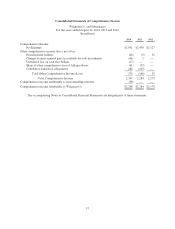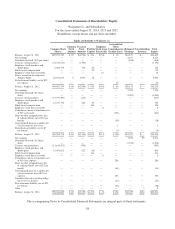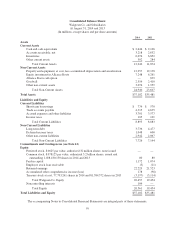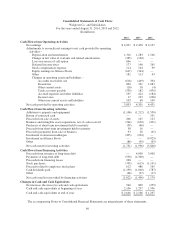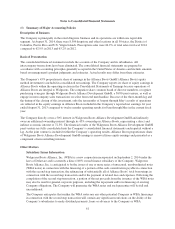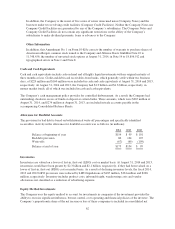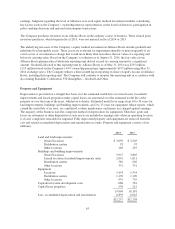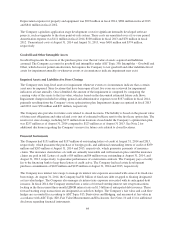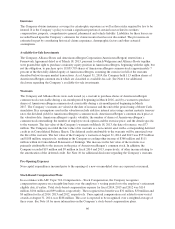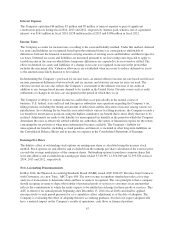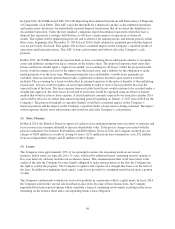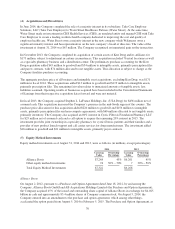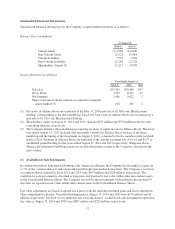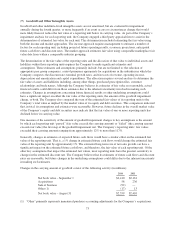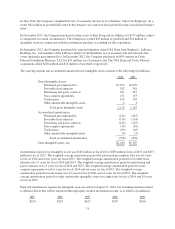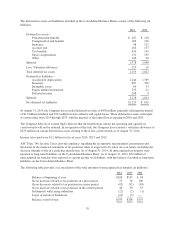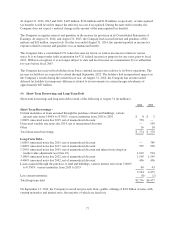Walgreens 2014 Annual Report Download - page 75
Download and view the complete annual report
Please find page 75 of the 2014 Walgreens annual report below. You can navigate through the pages in the report by either clicking on the pages listed below, or by using the keyword search tool below to find specific information within the annual report.Interest Expense
The Company capitalized $6 million, $7 million and $9 million of interest expense as part of significant
construction projects during fiscal 2014, 2013 and 2012, respectively. Interest paid, which is net of capitalized
interest, was $161 million in fiscal 2014, $158 million in fiscal 2013 and $108 million in fiscal 2012.
Income Taxes
The Company accounts for income taxes according to the asset and liability method. Under this method, deferred
tax assets and liabilities are recognized based upon the estimated future tax consequences attributable to
differences between the financial statement carrying amounts of existing assets and liabilities and their respective
tax bases. Deferred tax assets and liabilities are measured pursuant to tax laws using rates expected to apply to
taxable income in the years in which those temporary differences are expected to be recovered or settled. The
effect on deferred tax assets and liabilities of a change in tax rate is recognized in income in the period that
includes the enactment date. Valuation allowances are established when necessary to reduce deferred tax assets
to the amounts more likely than not to be realized.
In determining the Company’s provision for income taxes, an annual effective income tax rate based on full-year
income, permanent differences between book and tax income, and statutory income tax rates are used. The
effective income tax rate also reflects the Company’s assessment of the ultimate outcome of tax audits in
addition to any foreign-based income deemed to be taxable in the United States. Discrete events such as audit
settlements or changes in tax laws are recognized in the period in which they occur.
The Company is subject to routine income tax audits that occur periodically in the normal course of
business. U.S. federal, state and local and foreign tax authorities raise questions regarding the Company’s tax
filing positions, including the timing and amount of deductions and the allocation of income among various tax
jurisdictions. In evaluating the tax benefits associated with its various tax filing positions, the Company records a
tax benefit for uncertain tax positions using the highest cumulative tax benefit that is more likely than not to be
realized. Adjustments are made to the liability for unrecognized tax benefits in the period in which the Company
determines the issue is effectively settled with the tax authorities, the statute of limitations expires for the return
containing the tax position or when more information becomes available. The Company’s liability for
unrecognized tax benefits, including accrued penalties and interest, is included in other long-term liabilities on
the Consolidated Balance Sheets and in income tax expense in the Consolidated Statements of Earnings.
Earnings Per Share
The dilutive effect of outstanding stock options on earnings per share is calculated using the treasury stock
method. Stock options are anti-dilutive and excluded from the earnings per share calculation if the exercise price
exceeds the average market price of the common shares. Outstanding options to purchase common shares that
were anti-dilutive and excluded from earnings per share totaled 3,510,395, 12,316,949 and 32,593,870 in fiscal
2014, 2013 and 2012, respectively.
New Accounting Pronouncements
In May 2014, the Financial Accounting Standards Board (FASB) issued ASU 2014-09, Revenue from Contracts
with Customers, as a new Topic, ASC Topic 606. The new revenue recognition standard provides a five-step
analysis of transactions to determine when and how revenue is recognized. The core principle is that a company
should recognize revenue to depict the transfer of promised goods or services to customers in an amount that
reflects the consideration to which the entity expects to be entitled in exchange for those goods or services. This
ASU is effective for annual periods beginning after December 15, 2016 (fiscal 2018) and shall be applied
retrospectively to each period presented or as a cumulative-effect adjustment as of the date of adoption. The
Company is evaluating the effect of adopting this new accounting guidance, but does not expect adoption will
have a material impact on the Company’s results of operations, cash flows or financial position.
67


